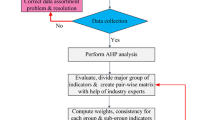Abstract
Lean as a business strategy is used to improve quality and service, eliminate waste, reduce time and costs, and enhance overall organizational effectiveness. Heightening challenges in competition in recent years have prompted many small and medium-sized enterprises (SMEs) to adopt lean to enhance firms’ competitiveness. This paper attempts to present an all-inclusive study and it examines various factors associated with the implementation of lean in SMEs in the U.S. The findings suggest that most of SMEs have a relatively accurate understanding of lean concept and philosophy. The primary reasons to implement lean are mainly internal, including reduce cost, improve profit margin, improve utilization of plant/facility, and maintain competitive position. A hierarchical cluster analysis was conducted to investigate lean status. It was discovered that both advanced adopters and beginners of lean are discovered. ANOVA test results show that there exist quite significant differences in terms of the degrees of lean implementation in SMEs. Varied lean tools and programs have been applied and they are positively related with firms’ performance. Lastly, the paper provides evidences that major lean barriers are encountered by SMEs regarding management or people related factors as well as key knowledge and know-how.



Similar content being viewed by others
References
Achanga, P., Shehab, E., Roy, R., & Nelder, G. (2006). Critical success factors for lean implementation within SMEs. Journal of Manufacturing Technology Management, 17, 460–471.
Cua, K., McKone, K., & Schroeder, R. G. (2001). Relationships between implementation of TQM, JIT, and TPM and manufacturing performance. Journal of Operations Management, 19, 675–694.
Holweg, M. (2007). The genealogy of lean production. Journal of Operations Management, 25, 420–437.
Jain, J., Ganagayach, G., Agarwal, G., & Banerjee, S. (2010). Supply chain management: literature review and some issues. Journal of Studies on Manufacturing, 1(1), 11–25.
James, T. (2006). Wholeness as well leanness. IET Manufacturing Engineer, 85(5), 14–17.
Karlsson, C., & Ahlström, P. (1996). Assessing changes towards lean production. International Journal of Operations & Production Management, 16, 24–41.
Krafcik, J. F. (1988). Triumph of the lean production system. Sloan Management Review, 30(1), 41–52.
Li, S., Rao, S., Ragu, T., & Ragu, B. (2005). Development and validation of a measurement instrument for studying supply chain management practices. Journal of Operations Management, 23(6), 618–641.
Liker, J. K. (2004). The Toyota way: 14 management principles from the world’s greatest manufacturer. New York: McGraw-Hill.
Little, D., & McKinna, A. (2005). A lean manufacturing assessments tool for use in SMEs. In Proceedings of the seventh SMESME international conference: stimulating manufacturing excellence in small & medium enterprise, United Kingdom.
Panizzolo, R. (1998). Applying the lessons learned from 27 lean manufacturers. The relevance of relationships management. International Journal of Production Economics, 55, 223–240.
Pil, F., & MacDuffie, J. (1996). The adoption of high-involvement work practices. Industrial Relations, 35(3), 423–455.
Poppendieck, M. (2002). Principles of lean thinking. USA: Poppendieck.LLC.
Wang, J., & Zhou, B. (2010). Supply chain optimization, management and integration: current state and future trends. In J. Wang (Ed.), Supply chain optimization, management and integration: emerging applications. Hershey: IGI Publishing.
Ward, P., & Zhou, H. (2006). Impact of information technology integration and lean/just-in-time practices on lead-time performance. Decision Sciences, 37(2), 177–203.
Womack, J., Jones, D. T., & Roos, D. (1990). The machine that changed the world: the triumph of lean production. New York: Rawson Macmillan.
Womack, J., & Jones, D. T. (1994). From lean production to the lean enterprise. Harvard Business Review, 72, 93–104.
Wong, M. (2007). The role of culture in implementing lean production system. In J. Olhager & F. Persson (Eds.), IFIP international federation for information processing (Vol. 246, pp. 413–422). Boston: Springer.
Wong, Y., Wong, K., & Ali, A. (2009). A study on lean manufacturing implementation in the Malaysian electrical and electronics industry. European Journal of Scientific Research, 38(4), 521–535.
Worley, J. M., & Doolen, T. L. (2006). The role of communication and management support in a lean manufacturing implementation. Management Decision, 44, 228–245.
Sakakibara, S., Flynn, B., Schroeder, R., & Morris, W. (1999). The impact of just-in-time manufacturing and its infrastructure on manufacturing performance. Management Science, 43, 1246–1257.
Shah, R., & Ward, P. (2003). Lean manufacturing: context, practice bundles and performance. Journal of Operations Management, 21, 129–149.
Sharp, J., Irani, Z., & Desai, S. (1999). Working toward agile manufacturing in the UK industry. International Journal of Production Economics, 62, 155–169.
Zhou, B., Zhao, Y., & Katehakis, M. (2007). Effective control policies for stochastic inventory systems with a minimum order quantity and linear costs. International Journal of Production Economics, 106, 523–531.
Zhou, B., Katehakis, M., & Zhao, Y. (2009). Managing stochastic inventory systems with free shipping option. European Journal of Operational Research, 196, 186–197.
Acknowledgements
We would like to thank the editor and the anonymous referees for their valuable comments and suggestions. They have significantly helped us improve the paper into this version.
Author information
Authors and Affiliations
Corresponding author
Rights and permissions
About this article
Cite this article
Zhou, B. Lean principles, practices, and impacts: a study on small and medium-sized enterprises (SMEs). Ann Oper Res 241, 457–474 (2016). https://doi.org/10.1007/s10479-012-1177-3
Published:
Issue Date:
DOI: https://doi.org/10.1007/s10479-012-1177-3




